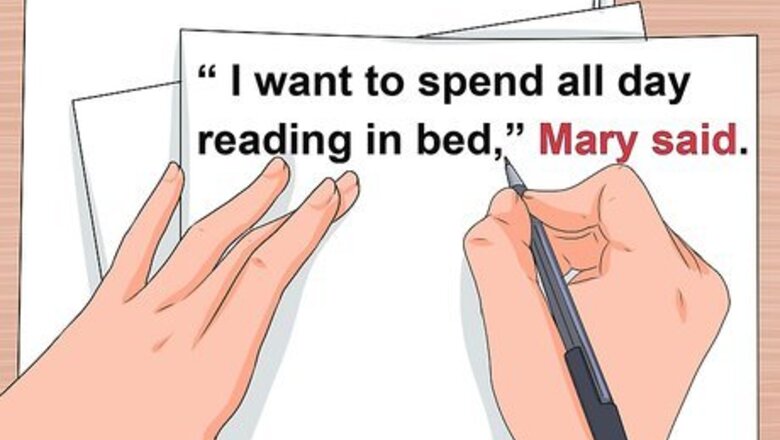
views
Getting the Basics Down
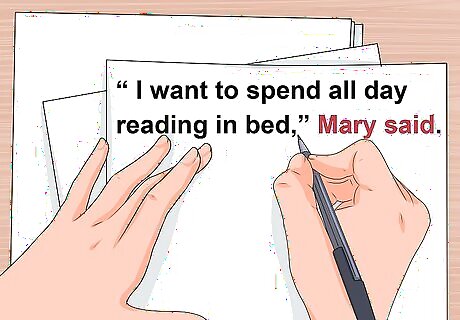
Punctuate a sentence that ends with a dialogue tag. When you're writing dialogue, the most important thing to remember is to put the dialogue that was said in quotes, and to end the dialogue with a comma within the quote if you're going to tag it, or attribute it to a speaker. Using a comma followed by an end quote and then a verb and the name or pronoun of the person who said it, or followed by the name and then the verb, is the most common way to punctuate dialogue. Here are some examples: “I want to spend all day reading in bed,” Mary said. “I wish I could do that, but I have to go to work,” Tom said. “You can get some rest over the weekend,” said Mary.
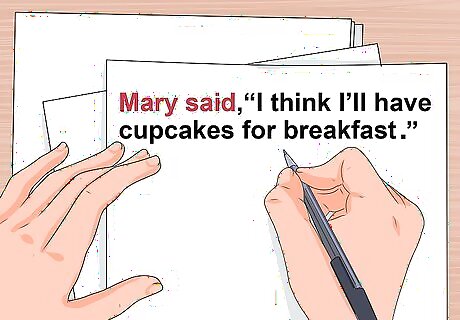
Punctuate a sentence that starts with a dialogue tag. When you start a sentence with a dialogue tag, then the same rules apply, except you'll be using a verb and a noun at the beginning of a sentence followed by a comma, an opening quote, the dialogue, a period or another form of closing punctuation, and another quote. Here are some examples: Mary said, “I think I'll have cupcakes for breakfast.” Tom said, “Do you think that's the healthiest option?” She said, “Absolutely not. Which is exactly what makes it appealing.”
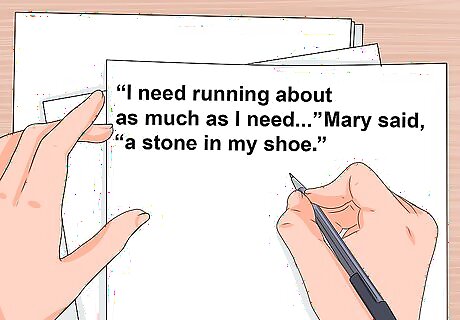
Punctuate a sentence with a dialogue tag in the middle. Another way to punctuate dialogue is to write a sentence with a dialogue tag in the middle. This is a way of creating a pause while continuing the sentence. To do this, you should tag the first part of the sentence as you normally would, except that you don't put a period at the end and use a comma to introduce the second half of the sentence instead. The thing to keep in mind is that you shouldn't capitalize the second half of the same sentence or thought. Here are some examples: “I'd like to go running,” Mary said, “but I'd rather just sit in this rocking chair.” “There are few things more appealing than sitting in that rocking chair,” Tom said, “but sometimes running may be just the thing you need.” “I need running about as much as I need…” Mary said, “a stone in my shoe.”
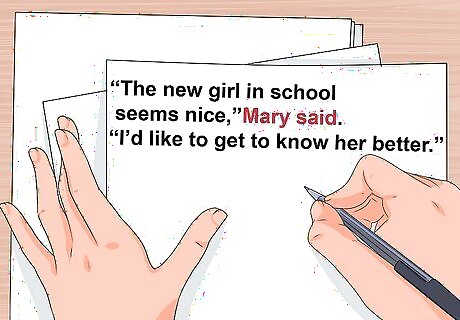
Punctuate a sentence with a dialogue tag in between two sentences. Another way to punctuate dialogue is to tag one sentence as you normally would, using a period at the end, and then starting a new sentence without attributing the dialogue to anyone. It should be clear from the context that the same person is speaking. Here are some examples: “The new girl in school seems nice,” Mary said. “I'd like to get to know her better.” “I thought she was a little bit stuck up,” said Tom. “That's pretty generous of you.” “I don't know about that,” Mary said. “I just like to give people a chance. You should try it.”
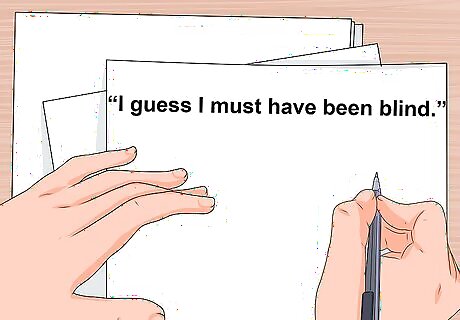
Punctuate dialogue without a tag. A lot of dialogue doesn't need to be tagged at all. It should be obvious from the context who the speaker is. You can also mention the people who are speaking next to the sentences they speak, so it becomes more clear who is talking. You don't want your readers to go line chasing, or trying to work backwards to figure out who is speaking in a two-person conversation with unattributed dialogue. At the same time, you don't want to get redundant with saying “she said” or “he said” every time someone speaks. Here are some examples: “I just don't think this is working anymore.” Mary fiddled with her pen. Tom looked down at the floor. “How can you say that?” “I can say it because I feel it. This isn't working, Tom. How can you not see it?” “I guess I must have been blind.”
Using Other Punctuation
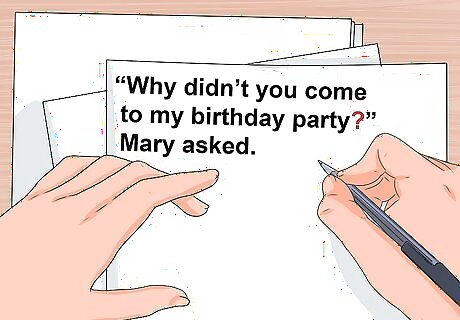
Punctuate dialogue with a question mark. To punctuate dialogue with a question mark, simply place the question mark before the end quote, replacing the usual period you would use. The tricky part is that, though it may look strange, you should tag the dialogue with a lower-cased “said” or another speaking verb, because this will still technically be part of the same sentence. Alternately, you can tag the question at the beginning of the sentence or leave out the tag altogether. Here are some examples: “Why didn't you come to my birthday party?” Mary asked. Tom said, “I thought we were broken up. Aren't we?” “Since when is that a good excuse to ditch someone's party?” “What better excuse can there be?” said Tom.
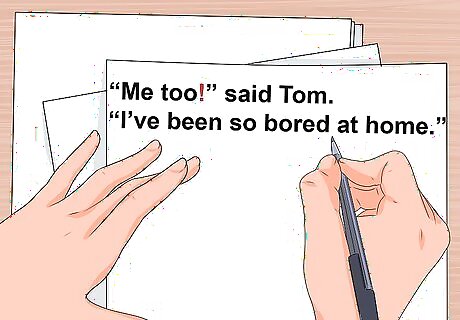
Punctuate dialogue with an exclamation mark. To punctuate your sentences with an exclamation mark, follow the same protocol you'd use to punctuate a sentence with a period or a question mark. Most writers would tell you that exclamation marks should be used sparingly, and that the sentence and story itself should convey excitement. Still, an occasional exclamation mark never hurt anybody. Here are some examples: “I can't wait for summer to be over so I can go back to school!” said Mary. “Me too!” said Tom. “I've been so bored at home.” Mary said, “You're telling me! I've started three ant collections in this month alone.”

Punctuate dialogue with quotes inside of it. This can be a bit tricky and won't be used very frequently, but it can be useful to know how to punctuate dialogue with quotes inside of it. Just use a single quote at the end and beginning of the quoted phrase, which could be the name of a work of art, or a quote attributed to another person. Here are some examples: “My favorite Hemingway story is 'Hills Like White Elephants,'” Mary said. “Didn't our English teacher say it was 'the world's most boring story'?” asked Tom.
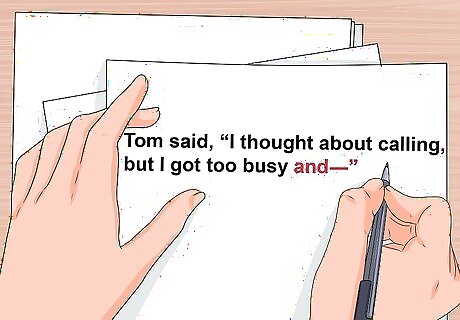
Punctuate dialogue that is interrupted. If you're writing dialogue between two characters, then if you want to be believable, they won't always politely wait their turns to speak. Sometimes they may interrupt each other in mid-sentence, just as real people often do. To show this interruption, you can use a dash at the end of the interrupted sentence, provide the sentence that is interrupting the original speaker, and consider using a dash at the beginning of the sentence if it is picked up again. Here are some examples: Tom said, “I thought about calling, but I got too busy and —” “I'm tired of your excuses,” said Mary. “Every time you don't call —” “This is different,” Tom said. “I promise.”
Mastering the Subtleties
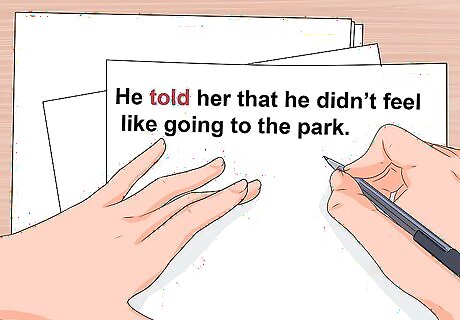
Punctuate a sentence that uses indirect dialogue. Not all dialogue has to be explicitly stated or placed in quotes. Sometimes, it's not important to state exactly what each character said, but to get across the general idea that it was stated. This can offer some relief to readers who are tired of reading dialogue and it can also be a way to avoid directly stating something that is better off explained indirectly. Here are some examples: He told her he didn't feel like going to the park. She said she didn't care whether or not he came with her. He said she needed to stop being so sensitive all the time.
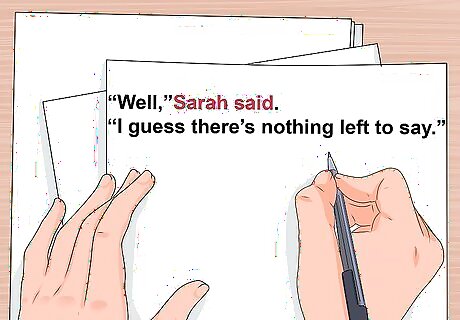
Use a dialogue tag to indicate a pause. Another thing you can do is break up a sentence with a dialogue tag to indicate a pause or to show that the character is thinking or struggling to find something to say. This can help add tension to a conversation and can also make it feel more realistic at times; not everyone can come up with the perfect statement on command. Here are some examples: “Well,” Sarah said. “I guess there's nothing left to say.” “I knew that,” said Jerry. “But I wanted you to figure it out for yourself.”
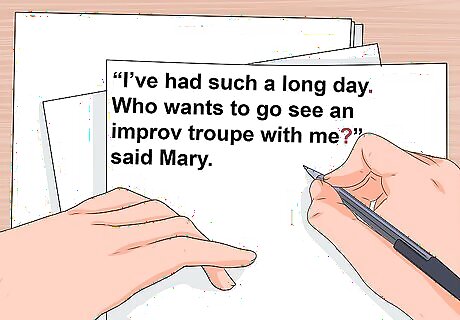
Punctuate dialogue that uses multiple sentences. You don't need to tag every single sentence of dialogue or to make it so every character only says one sentence before another character speaks. Sometimes, a character will speak at greater length, and you can show this simply by quoting one sentence after another until the character is done talking; then, you can either just place end punctuation on the end of the last sentence or attribute the dialogue to a character using a tag. Here's how it will look: “I've had such a long day. Who wants to go see an improv troupe with me?” said Mary. Jake said, “I'd rather hang out with my dog than go to work any day. He's so helpless without me.”
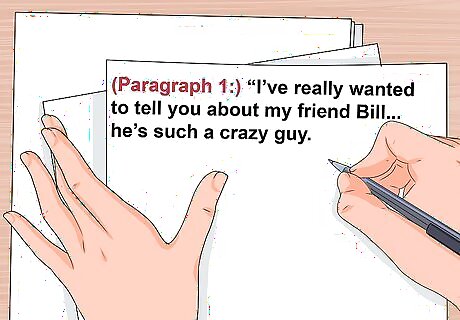
Punctuate dialogue that carries over into multiple paragraphs. Sometimes, a character may speak for multiple paragraphs without stopping. To indicate this through correct punctuation, you should open the quote for the first paragraph, write down what the character says, and end the paragraph with either a period, a question, or an exclamation mark. Then, start the second paragraph with an open quote and keep going until the character is done speaking. When this happens, just close the quote with end punctuation as you normally would. Do it like so: (Paragraph 1:) “I've really wanted to tell you about my friend Bill...he's such a crazy guy. (Paragraph 2:) “Bill owned a cactus farm but sold it to live on a sailboat. Then he sold the boat to start building a castle, but he got tired of that and decided to swim across the Atlantic ocean instead.”
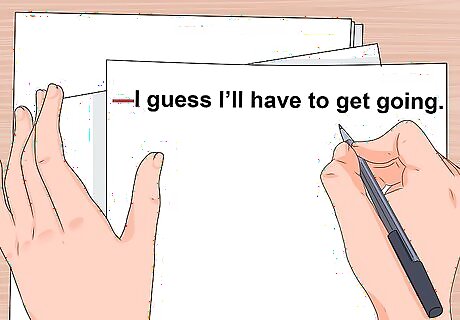
Punctuate dialogue using dashes as tags instead of commas. Not every country uses quotes to indicate that characters are talking. Some countries, such as Russia, France, or Spain, rely on using the dash to indicate that someone is talking instead. In this method, you don't need to tag the dialogue and need to trust the reader to understand who is speaking. If you use it, you have to use it consistently throughout the piece of writing. This can take a bit of practice, but it can create an interesting effect if you're committed to it. Here is an example: —I guess I'll have to get going. —That's fine by me. —So long, then.
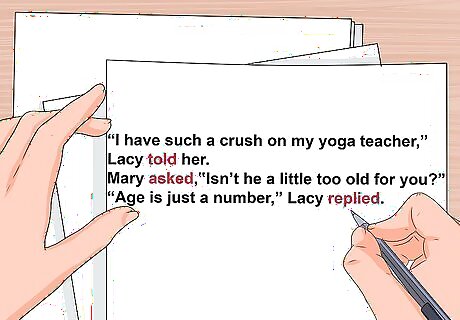
Consider using verbs other than “said” to tag dialogue. Though writers such as Hemingway or Carver rarely use any dialogue tag but “said,” you can occasionally use a different tag if it feels more appropriate. While there's no need to weary your reader with elaborate or overly-fancy sounding verbs such as “inquired” or “questioned,” you can occasionally use other verbs for a breath of fresh air. Here are some examples: “I have such a crush on my yoga teacher,” Lacy told her. Mary asked, “Isn't he a little too old for you?” “Age is just a number,” Lacy replied.




















Comments
0 comment